 Hawaiian Name(s): ‘awa, pū‘awa
Hawaiian Name(s): ‘awa, pū‘awaScientific Name: Piper methysticum
Vernacular Name: kava
Family: Piperaceae
Status: Polynesian introduced
Authority: G.Forst.
Description: Large rounded shrub with segmented branches; 4-12 ft.
Habitat P. methysticum is widely planted and persists in moist lower forest to open windward valleys between 50–500 m on most main islands (Wagner et al. 1990:1036–1037).
Medicines: ‘Awa is used to treat a wide variety of ailments, such as insomnia; the ashes are rubbed on lesions of thrush/fungal disease (‘ea, pa‘ao‘ao) of children; also for kidney disorders, chills, chewed for headaches, and tiredness. Root extract used in remedies to relieve difficulty in urinating, menstrual irregularities, and congestion in the respiratory tract (Chun 1994:51–59).
Non Medicinal Uses: Most commonly known as a relaxant. Used in a wide variety of social settings, including ceremonies of various types. Also blended with other substances for healing purposes. The active chemicals in 'awa are called kavalactones, which are mainly composed of varying ratios of 6 different chemicals; they are (numbered from 1 through 6): 1) demethoxy-yangonin (DMY); 2) dihydrokavain (DHK); 3) yangonin (Y); 4) kavain (K); 5) dihydromethysticin (DHM); and 6) methysticin (M). The components have differing physiological effects; studies have shown that DHK and DHM are the most potent kavalactones, while kavain is most quickly absorbed when drunk and is highly valued for its pleasant effects, including relaxed mental and physical state, improved ability to think, and stabilization of feelings. While it is possible to extract an individual component for use, it is the synergistic combination of all the chemicals that produces best results. (Lebot et al.1992).
Specific gravity of wood: unknown
Famous Locations:
Mele: He ‘Awa i Kanu ‘ia e ke Akua: ‘Awa oli for Pele (Pukui 1995: 4)
`Ōlelo Noeau: [I] ‘Awa kau la‘au o Puna. Tree-growing ‘awa of Puna. Tree-grown ‘awa of Puna was famous for its potency. It was believed that birds carried pieces of ‘awa up into the trees where it would grow. [II] E hanai ‘awa a ikaika ka makani. Feed with ‘awa so that the spirit may gain strength. One offers ‘awa and prayers to the dead so that their spirits may grow strong and be a source of help to the family. [III] Ka ‘awa lena o Kali‘u. the yellowed ‘awa of Kali‘u. Refers to Kali‘u, Kaua‘i. People noticed drunken rats in the forest and discovered some very potent ‘awa there. There is a Kali‘u in Puna, Hawai‘i, where good ‘awa is also grown. [IV] O Honu‘apo aku no ia o kahi o ka ‘ahu‘awa. That is Honu‘apo where the ‘ahu‘awa grows. A Ka‘u saying about disappointment. The ‘ahu‘awa was much used as fiber for straining ‘awa. A play on hoka (to strain, to be disappointed). [V] Paoa ka lawai‘a i ka ‘olelo ia o ka ‘awa. Unlucky is fishing when ‘awa is discussed. ‘Awa (kava) also means "bitterness." [VI] Puna, ‘aina ‘awa lau o ka manu. Puna, land of the leafed ‘awa planted by the birds.
Dye Color and Parts:
Kino lau:
Location on Bishop Museum Kalihi Campus: near Castle Bldg
Propagation Information: (Handy et al. 1972:191–192)
